Fatalities on Mumbai’s suburban rail system, whether due to overcrowding or unlawful trespassing, occur with disturbing regularity. The statistics overshadow the phenomenal scale of the daily operations—perhaps the highest passenger density on any urban transport network globally.
The fact that the average daily death toll has dropped from around 15 fatalities a few decades ago to 7 now is no real achievement by the public transporter, Indian Railways. The number of fatalities on the Mumbai suburban network is still the highest in the world.
These are not suicides. They are deaths caused by well-known and preventable reasons. They’ve been flagged years ago but there’s little to show for it on the tracks.
The Mumbai suburban rail system has been studied, filmed, documented, and researched in every possible way. The traditional vertical network connects Churchgate and CSMT in south Mumbai with the northern and eastern suburbs over a stretch of over 50 km. It caters to over seven million commuters daily. Called the ‘lifeline’ of this commercial metropolis, it keeps Mumbai moving. No other mode of transport, be it city buses or the sporadic Metro lines, can absorb this volume.
The city’s suburban commuters make up an estimated 40 per cent of Indian Railways’ total passenger traffic. In 2023-24, the Railways recorded a total of 6,947 million passengers, of which 4,026 million were suburban travellers. The Mumbai network alone carried 7.56 million passengers daily, marginally below its pre-COVID levels of over 8 million. Of these, about 3.5 million travelled on Western Railway (WR) and 4.5 million on Central Railway (CR).

Overall, 3,000 local train services are provided daily—over 1,300 on WR between Churchgate and Dahanu, and around 1,700 services on CR, covering the CSTM –Kasara/ Panvel and Thane-Vashi sections. Only about 80 of these services have air-conditioned rakes. The network operates 9/12/15 car rakes on different sections. AC services, introduced in 2017, are not very popular because of their limited carrying capacity and higher pricing (the fares were revised downwards since 2022, which has had some positive impact).
The network passes through densely populated clusters and busy commercial centres. The local trains travel at speeds of 100 kmph, running at intervals of 3 to 4 minutes during peak hours. Mumbai’s narrow longitudinal geography adds to the strain of its transport systems. Even as workplaces and business hubs are shifting to central, east, and north Mumbai, the pressure of north-south commuter traffic continues.
Capacity saturation has been reached, with the minimum possible headway between trains already being utilised. The result is chaos at suburban stations during peak hours. Overcrowding is a given on services that still mostly operate with 9 and 12-car rakes.
Footboard travellers hanging on to door handles, holding on to one another and precariously balancing backpacks and lunch boxes is a common sight. It’s out of compulsion. These trains are the cheapest and fastest way to travel. A ticket can cost as little as Rs 20, and a second-class monthly season pass is priced at the cost of just 15 single journeys, irrespective of the number of journeys actually undertaken.
Broadly, Indian Railways subsidises over 75 % of the costs per passenger-kilometre for suburban services. With heavy subsidies, suburban services recover only about 24 per cent of costs making it a hugely loss making passenger service segment.
Technically, all train accidents are categorised and recorded in the Railway Accident Manual. Broadly, they are classified as ‘Consequential’ and ‘Indicative’. A “train accident” must involve the train itself—such as a collision or derailment. By contrast, incidents involving commuters falling from running trains or trespassing on tracks, even if fatal, are not classified as accidents but as “Untoward Incidents”, for which the Railways’ responsibility is limited.
Under Section 147 of the Indian Railways Act, 1989, trespassing and refusal to desist from trespassing are offences punishable with both fines and imprisonment. Falling from a running train is covered under Section 123C, ‘Untoward Incidents’. In such cases, Section 124 and 124A make the Railways liable to pay compensation for death or injury, except when such incidents are suicide or criminal acts.
According to various reports, between 2002 and 2012, more than 36,000 commuters lost their lives on Central and Western Railways. In certain years, the average reached 15 deaths a day. In filed by Indian Railways in the Bombay High Court in 2024, it was stated that 51,802 people lost their lives, and a similar number were injured, on the Mumbai suburban system between 2005 and 2024. Most of these deaths were on account of trespassing, falling from trains, or being struck by poles. Of the total fatalities in this period, 22,481 occurred on Western Railway and 29,321 on Central Railway. It is also reported that 2,590 deaths occurred in 2023 and 2,468 in 2024 on the Mumbai suburban system.
Deaths and injuries to commuters occur mostly due to overcrowding. Without any access control or regulation of passenger flow in and out of stations, and with local services running open-door compartments, overcrowding invariably leads to footboard travelling. People fall to their deaths from running trains with disturbing regularity. Out of the average 7 deaths daily, about 2 to 3 are on this account. Another 3 to 4 are due to trespassing across local tracks, either for changing platforms or taking a shortcut in the mid-section.
At the station, the causes for trespass are well known: inadequacy of foot overbridges, open-ended platforms, inadequate fencing between tracks.
Some improvements are being made, albeit in an incremental manner. However, three primary measures have not been fully addressed in a focused and time bound manner—access control at stations, 15-car rakes with closed-door coaches, and high pilferage-proof fencing along the entire suburban network.
With the sectional capacity of both WR and CR utilised over 100 per cent, and the headway of 3 to 4 minutes already achieved, there is hardly any margin left for introducing more services.
This brings us to the only viable solution: increasing the length of trains. All rakes should be converted to 15-car rakes. The capacity of a 15-car rake is 25 per cent more than that of a 12-car rake. While WR runs over 200 such services, CR has only about two dozen.
Yet, a proposed project to convert all rakes to 15-car remains unimplemented.
The Public Accounts Committee (PAC) of Parliament, in its 2017 report on Suburban Train Services in Indian Railways, stated that the numbers of fatalities and injuries due to line crossing, falling off from running trains, and so on were “really shocking”. It also noted that 6,000 of these 15,000 deaths at the time were “reported from the Mumbai Suburban Rail System alone.”
In its recommendations, the PAC specifically mentioned the loss of lives of passengers in suburban train services. It took note of measures like provision of foot overbridges (FOBs), escalators, etc., to reduce trespassing, and recommended elimination of line crossings through provisions of foot over ( FOBs)and foot underbridges (FUBs), fencing and boundary walls on both sides of railway lines, and removal of encroachments. To eliminate deaths from falling off trains, the PAC recommended that the Ministry of Railways take urgent action to redesign suburban train coaches with automatic doors and to increase the number of coaches to 15 on each train.
Capital expenditure for all infrastructure-related development on the Mumbai suburban system is undertaken by the Mumbai Rail Vikas Corporation Ltd. (MRVC), a public sector undertaking under the Ministry of Railways. It executes the rail component of the Mumbai Urban Transport Project (MUTP).
In the past, MUTP I was allocated Rs 4,452 crore for laying 5th and 6th lines, procurement of 9-car rakes, and rehabilitation and resettlement (R&R). MUTP II was sanctioned with Rs 8,087 crore, and MUTP III (2015-16) had an allocation of Rs 10,947 crore. The latest phase, MUTP IIIA, has an allocation of Rs 33,690 crore. In MUTP III, Rs 551 crore was allocated for trespass control measures in mid-sections.
It is evident that despite being a loss-making service segment, adequate funding is being provided. Now, allocation toward 15-car rakes, retrofitting of doors, and other related measures needs to be increased.
Indian Railways will have to look at Metro systems like the DMRC to gradually transform its suburban services to similar standards, especially in terms of passenger safety and comfort. Metro rakes are all air-conditioned and have automatic door closures, eliminating footboard travel. The tracks are either fenced, elevated, or underground, removing scope for trespassing. DMRC now has a ridership of over 4.5 million daily—at par with Central/Western Railways—with no fatalities due to trespass or falling from trains, occasional suicides notwithstanding.
Although the PAC made its recommendations in 2017, the situation has hardly improved. Many of the measures are still not in place. After the 9 June incident, the Ministry of Railways announced that all new rakes would have automatic doors, and existing ones would be retrofitted—this recommendation was also made by PAC in 2017.
Last year, public concern over commuters’ deaths was also reflected in Public Interest Litigation (PIL) No. 75 of 2024 in the Bombay High Court.
The PIL highlighted the thousands of deaths taking place every year due to falls and trespassing, attributing this to inadequate infrastructure and inaction by the Railway Administration.
On 26 June, the bench headed by the Chief Justice of Bombay High Court, while admitting the PIL, made serious observations against the Railways, it is reported.
It : “A very serious issue has been raised in the PIL, and therefore it must be addressed. You cannot cite the large number of people in the city as an excuse for inaction.”
The PIL was admitted, and Railways as respondents were directed to file affidavits. The order also said the issue needs urgent attention at the higher level of Railway administration, and that the court may consider setting up a committee of experts to suggest enforceable safety measures. A final decision is awaited, which may lay down stiff targets and directions for the Railways.
Finally, the question is, whose responsibility is it anyway?
The extant legal provisions categorically holding passengers responsible for such deaths and injuries (Indian Railways Act Sections 147 and 123C), the only available relief is through Section 124A, which allows for compensation in certain cases of falling from trains, under specified conditions. These cases too get decided after a prolonged legal process before the Railway Claims Tribunal.
Additionally, the right of way lies with the Railways, and these cases are not even classified as accidents but as “Untoward Incidents.” Efforts are made toward prevention through infrastructure improvements, but the burden of responsibility remains diffused.
The state government has an equally important role—clearing encroachments, managing crowding at stations, developing Metro networks at a faster pace, or even considering staggered office timings.
But no one accepts full responsibility. Each has its own justification. In the end, it boils down to: (No one is to blame. No one is responsible.)
Eliminating these incidents entirely may not be possible, but reducing the factors causing this shocking number of fatalities on Mumbai’s suburban network is certainly doable. It’s time for focused, time-bound attention on two fronts. First, ensure that all rakes have 15 coaches. This would increase capacity by 25 per cent and significantly ease overcrowding. Second, install doors on all new rakes and retrofit existing ones to prevent cases of falling from running trains.
Introducing air-conditioned 15-car rakes must be the final solution for safety and comfort. Construction of a high boundary wall all along the suburban network on CR and WR could eliminate trespassing in mid-sections. Other measures like FOBs may continue to be provided.
Finally, it is extremely disturbing that thousands of precious lives are lost on the Mumbai suburban network every year. In the past, and even now, senior motormen operating these local trains, after such incidents would sign off from duty for the day due to the traumatic experience. Whatever its gravity, the unabated occurrence of an event usually turns into a routine—and routines are never the top priority for action.
On a philosophical note, it’s all about what John Donne famously wrote: “No man is an island, Entire of itself. Each is a piece of the continent, A part of the main. Each man’s death diminishes me, for I am involved in mankind.”
(Edited by Asavari Singh)








